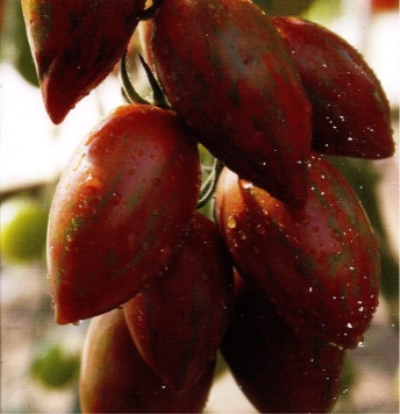
- Authors: Lukyanenko A.N., Dubinin S.V., Dubinina I.N.
- Year of approval: 2007
- Category: hybrid
- Growth type: indeterminate
- Appointment: fresh consumption, for whole fruit preservation
- Ripening period: mid-season
- Ripening time, days: 115-120
- Growing conditions: for open ground, for film greenhouses
- Marketability: high
- Bush size: tall
Recently, exotic types of tomatoes are becoming more and more popular, which are easy to grow, attractive in appearance, and are also very useful for the human body. Among these, one can distinguish the Chocolate tomato, which grows both in greenhouses and in a garden bed.
Breeding history
A tomato with the beautiful name Chocolate was bred by Russian breeders (S.V.Dubinin, A.N. Lukyanenko, I.N.Dubinina) in 2004. The nightshade crop was approved for use and entered into the State Register of Breeding Achievements of the Russian Federation in 2007. The tomato is ideal for growing in the middle lane and southern regions of the country. In the northern part, the tomato is only productive when grown in film greenhouses.
Description of the variety
A mid-season tomato is a tall bush of an indeterminate type, growing up to 180-200 cm. The plant is characterized by weak thickening with large green leaves, medium branching, a strong central stem, a developed root system and simple inflorescences. The first fruit cluster is formed above the 8th leaf. On average, 9 to 11 tomatoes are tied in each fruit cluster.
When growing this type, do not forget about the formation of bushes in 1-2 stems, the regular removal of stepchildren and a garter to the supports, since the weight of the fruit brushes contributes to the deformation and breaking of the branches of the bushes. In addition, the lower leaves need to be thinned to provide sufficient oxygen to the plant's root system. Some experienced gardeners recommend pinching the top.
The universal purpose of tomatoes allows them to be widely used in cooking, to be eaten fresh, canned and processed into ketchup, dressings. In addition, the variety is ideal for whole-fruit preservation.
The main qualities of the fruit
Tomato Chocolate is the most exotic representative of small-fruited nightshades. The average weight of a tomato is 30-40 grams. The berries grow obovate (oblong or plum-shaped). The unusual color of the fruit attracts attention - brown with small green strokes in a state of absolute ripeness. At the stage of technical maturity, the tomatoes are covered with a green color.
The peel of vegetables is moderately dense, smooth and glossy. The fruits are resistant to cracking, easily transported and stored for a long time without losing their attractive appearance and taste. Tomatoes that are too overripe on the bushes are prone to cracking.
Taste characteristics
The taste of vegetables is as interesting as the presentation. The tomato pulp is dense, fleshy, oily, very juicy, with a small amount of small seeds. The taste is dominated by sweetness, light sugar content, harmoniously combined with a spicy aroma.
Ripening and fruiting
The variety is mid-season, therefore, from the moment of germination of sprouts to ripe berries, 115-120 days pass on the branches. Fruiting in the culture is extended, so you can enjoy delicious tomatoes for a long time. Tomatoes ripen on the brush together, so you can shoot them together. The peak of fruiting occurs in the period from July to September.
Yield
The yield of this species is good.Observing the recommendations on agricultural technology, 6.2 kg of vegetables can be grown and harvested per 1 m2. In the garden, 2-3 kg of tomatoes are removed from 1 bush.
The timing of planting seedlings and planting in the ground
It is recommended to sow seeds throughout March. Before this, the seed is carefully sorted and disinfected. Mass germination occurs on the 6-8th day. The plant is thermophilic, therefore it is recommended to maintain stable temperature and light conditions in the room - 20-22 degrees and lighting for 12-14 hours. The dive is carried out at the stage when each plant has 2-3 leaves. Do not forget about feeding and watering. If desired, the bushes can be slightly prepared for transplantation - by hardening them daily, exposing them to fresh air.
At the age of 50-55 days, seedlings can be transplanted to a permanent place of growth. In open ground, planting is carried out in the second half of May, and in greenhouses a few weeks earlier.

Growing tomato seedlings is an extremely important process, because it largely depends on whether the gardener will be able to harvest at all. All aspects must be taken into account, from seedbed preparation to planting in the ground.
Landing scheme
There are 3 bushes per 1 m2. The optimal scheme for planting is considered to be 40x50 cm.

Growing and care
Tomatoes love loose, airy, moisture-permeable and fertile soil. Agrotechnics for the plant are standard - moderate watering, fertilizing, weeding and loosening the soil, pinching, garters and the formation of bushes, as well as the prevention of viruses.




A plant needs different micronutrients at each stage of growth. All fertilizers can be divided into two groups: mineral and organic. Folk remedies are often used: iodine, yeast, bird droppings, eggshells.
It is important to observe the rate and period of feeding. This also applies to folk remedies and organic fertilizers.
Disease and pest resistance
The hybrid is characterized by high resistance to many tomato diseases - tobacco mosaic virus, fusarium wilting, apical and root rot, verticillosis. The plant is rarely affected by late blight due to its early maturity.Treatment with copper-containing preparations will help to avoid infection with fungal diseases.


Resistant to adverse weather conditions
The tomato is resistant to temperature extremes, short-term drought and heat.

























































































